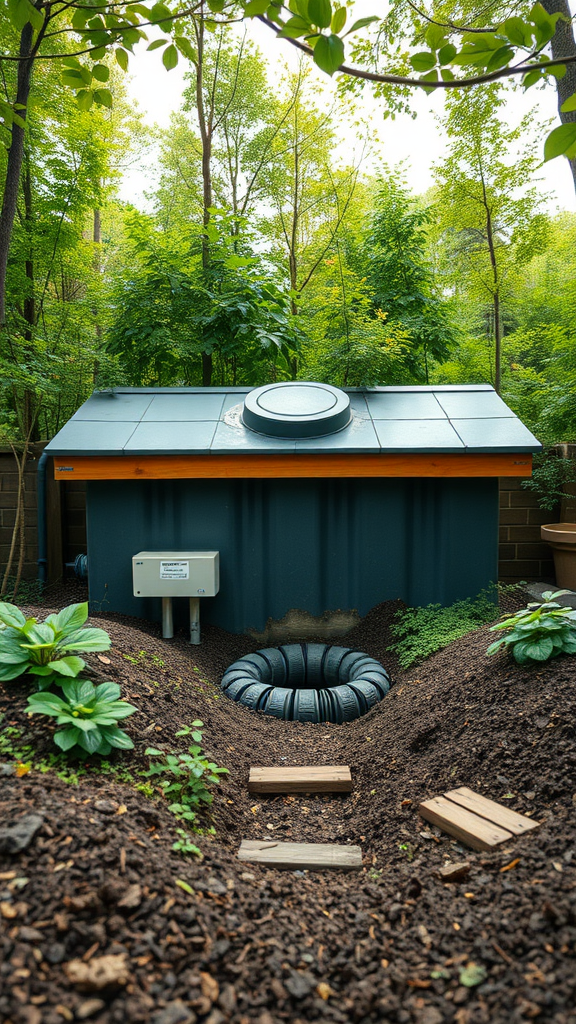Understanding Composting Septic Systems: Benefits and Functionality
Composting septic systems are an innovative solution for both waste management and soil enrichment. They function by combining standard septic technology with a composting process that breaks down waste sustainably. Understanding how these systems work and the benefits they offer can help homeowners and land developers make informed choices about waste treatment options.
How Composting Septic Systems Operate
A composting septic system primarily comprises three key components: the septic tank, the composting chamber, and the soil treatment area. Here’s how each part functions:
- Septic Tank: This is where wastewater from your home first collects. Here, solids settle at the bottom, forming sludge, while grease and lighter waste float to the top, creating scum. This initial treatment reduces the amount of solid waste.
- Composting Chamber: After the septic tank, the liquid waste enters the composting chamber. Here, aerobic microorganisms further digest the organic matter. These microbes require oxygen, which is provided through ventilation or specific materials that promote airflow. The result is a rich compost material.
- Soil Treatment Area: Once the composting process has adequately broken down the waste, the remaining liquid effluent is transferred to the soil treatment area. This area allows for natural filtration and further absorption into the ground, minimizing environmental impact.
The process is efficient because it significantly reduces the volume of waste while transforming it into nutrient-rich compost that can naturally benefit the soil.
Key Benefits of Composting Septic Systems
Using a composting septic system provides various advantages that make it an appealing choice for many homeowners. Here are some of the standout benefits:
- Environmental Sustainability: These systems help minimize pollution. By treating waste on-site, they reduce the need for large sewage treatment plants, decreasing the carbon footprint associated with transporting and treating waste.
- Enhanced Soil Quality: The compost produced can improve soil structure, increase nutrient content, and foster beneficial microbial life. This can be especially useful for gardens and landscaping.
- Cost-Effectiveness: In the long run, a composting septic system can save homeowners money. They often require fewer maintenance costs compared to traditional septic systems and can provide valuable compost for landscaping needs.
- Space Efficiency: Composting systems often occupy less space than conventional septic systems while handling waste more efficiently. This can be particularly valuable on smaller lots.
- Diverse Waste Handling: These systems can accept a wider variety of organic materials beyond human waste. This capability allows homes that practice composting in their kitchens to manage food scraps and biodegradable waste effectively.
Considerations for Installation
While composting septic systems offer many benefits, there are a few considerations to keep in mind:
- Local Regulations: Always check with local health departments or regulatory agencies to ensure composting systems meet regional codes and standards. Not all areas permit them.
- Professional Installation: For optimal performance, it’s essential to have these systems installed by professionals. Improper installation can lead to system failures or inefficiencies.
- Regular Maintenance: Although these systems are often less maintenance-intensive, they do require some ongoing care. This includes monitoring the composting process and possibly removing excess compost occasionally.
Composting septic systems represent a modern approach to waste management that aligns with ecological values. Ideal for the environmentally conscious homeowner and those seeking efficient, sustainable solutions, these systems transform waste into usable compost while protecting the environment. Whether you’re building a new home or looking to upgrade your current system, considering a composting septic system may be an excellent choice for your needs.
Best Practices for Maintaining a Composting Septic System
Maintaining a composting septic system requires a thoughtful approach to ensure it operates effectively and efficiently. These systems are designed to break down waste biologically and use that process to treat wastewater. Here are some best practices that you should follow to keep your composting septic system in tip-top shape.
Regular Inspection
Conducting regular inspections is crucial for identifying potential issues before they escalate. Aim to check your system at least once a year. During inspections, look for:
- Signs of leaks or standing water near the system.
- Odors that indicate an underlying problem.
- Blockages in pipes or venting systems.
If you notice something unusual, it’s best to call a professional to help diagnose the issue.
Monitor Waste Discharge
Keeping an eye on what goes down the drains is essential. Be mindful of what enters your composting septic system, as some items can cause clogs or damage the system. Avoid flushing:
- Non-biodegradable items (plastic, wipes).
- Chemicals like strong cleaners and solvents.
- Grease and oils that can solidify and block lines.
Your system relies on helpful bacteria to break down waste, so maintaining a healthy balance is vital.
Maintain Proper Water Use
Using water wisely helps sustain your composting septic system. Here are a few tips to optimize water use:
- Spread out water usage over time instead of doing multiple loads of laundry in one day.
- Fix any leaky faucets or toilets to minimize waste.
- Install low-flow showerheads and faucet aerators to reduce water consumption.
By conserving water, you can prevent the system from becoming overloaded, which can lead to a backup or failure.
Add Carbon-Rich Material
Your composting septic system benefits from a balanced mixture of carbon-rich materials. Each time you flush waste, consider adding materials such as:
- Dry leaves.
- Straw.
- Coconut coir.
This helps create a healthy compost environment, encouraging the growth of beneficial bacteria that process waste effectively.
Regular Pumping
Just like traditional septic systems, composting septic systems also need regular pumping. Generally, this should happen every three to five years, depending on usage and local regulations. Regular pumping helps:
- Remove built-up sludge that can hinder system efficiency.
- Ensure that the composting process continues smoothly.
- Prevent odors and unpleasant backups.
Consult with your service provider on the best schedule for your specific system.
Manage Plant Growth
Be cautious about where you plant vegetation near the composting septic system. The roots of some plants can invade the system and cause serious damage. Here are some tips:
- Keep shrubs and trees away from the drain field.
- Consider planting only grass or shallow-rooted plants in this area.
These measures help protect your system while also maintaining a pleasant yard layout.
Educate Others in Your Household
It’s essential to educate everyone in your household about the proper care for your composting septic system. Make sure they understand:
- What can and can’t be flushed.
- The importance of conserving water.
- How to recognize signs of trouble in the system.
Awareness can lead to fewer mistakes and a healthier system overall.
By following these best practices, you can significantly enhance the longevity and efficiency of your composting septic system. Regular maintenance not only protects your investment but also ensures that your wastewater disposal is environmentally friendly and safe for your property.
Conclusion
Embracing a composting septic system is a proactive step towards sustainable living and effective waste management. By understanding how these systems function, you can appreciate the numerous benefits they offer. Not only do they reduce environmental impact by recycling waste into nutrient-rich compost, but they also promote healthier soil and plant growth, making them an excellent choice for eco-conscious homeowners.
To fully harness the advantages of a composting septic system, it is essential to adopt best practices for maintenance. Regularly monitoring the system, ensuring proper aeration, and being mindful of what goes down the drain are vital steps in keeping your system running efficiently. Additionally, scheduling periodic maintenance checks with professionals can help identify potential issues before they become significant problems.
Ultimately, the health of your composting septic system translates directly to the health of your garden and your contribution to sustainability. By investing the time and effort into understanding and maintaining your system, you’ll enjoy a cleaner environment and a more vibrant landscape. Taking these steps allows you to do your part for the planet while benefiting from a reliable, eco-friendly waste management solution. With a little diligence, you can ensure that your composting septic system thrives for years to come.
As an Amazon Associate, I earn from qualifying purchases.

